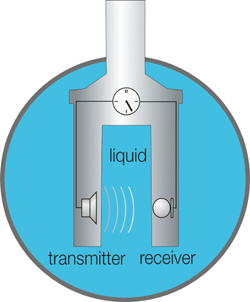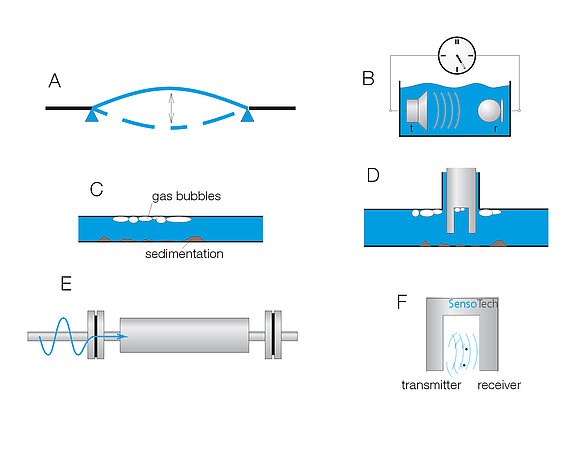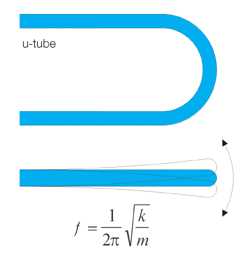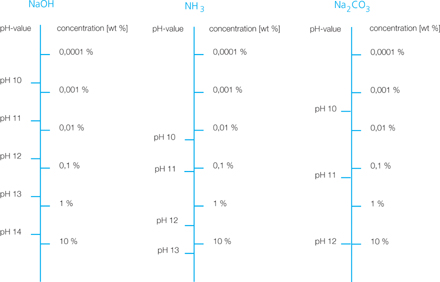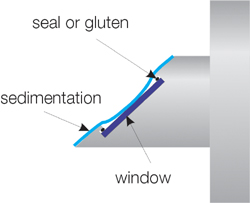Each of these measuring methods has advantages and disadvantages over the others. To find out, please click on the measuring methods.
Sonic velocity measurement
The LiquiSonic® technology is based on sonic velocity measurement. With this ultrasonic measuring method the concentration in a liquid can be determined accurately and quickly, as the sonic velocity in a liquid depends on the concentration of the each liquid component and the temperature.
To determine the sonic velocity, a signal is transmitted through the liquid and the time is measured until the signal reaches the receiver. Since the distance between the ultrasonic transmitter and receiver is constant, the sonic velocity can be calculated.
Properties of the LiquiSonic® measuring method:
- measurement is independent of the color, conductivity and transparency of the process fluid
- measuring accuracy of ±0.05 m/s
- high, drift-free measuring accuracy even at high proportion of gas bubbles
- updating of measuring values every 250 ms
- installation directly in pipelines or vessels
- bypass-free installation
- robust sensor design without gaskets or moving parts
- maintenance-free measurement technology
- insensitive to contamination
- use at temperature from –90 °C to 200 °C
- use at pressure up to 500 bar
- use of special sensor materials in corrosive liquids
- integrated temperature measurement
Coriolis density measurement
If a liquid stream runs through an oscillating tube, the phase shift of this oscillation depends on the Coriolis force and finally of the mass flow of the liquid stream.
Because Coriolis mass flowmeters are optimized for precise phase shifting determination, they have only poor performance for the measurement of the oscillation frequency, which is required for precise density measurement. That´s why concentration and density measurements only allow accuracies of ± 5 % to ± 10 % full scale with these instruments.
A concentration measurement with this technology has disadvantages:
- high sensitivity of gas bubbles and sediments
- in most cases the instruments have temperature compensation for the device, but not for the density calculation
- calibration is only possible in the factory
- difficult installation, especially for larger tube diameters
- high pressure lost because of internally reduced tube diameter
U-tube/vibrating density measurement
The vibrating u-tube densitometer is a proven and very precise method, especially for laboratory applications.
While using this method for process applications these instruments will have some limitations:
- maximum diameter of 10 mm, therefore a bypass will be required
- sensitive against pressure spikes
- no immersion type available
- high sensitivity against gas bubbles and sediments
Conductivity measurement
The conductivity of a liquid depends on the concentration and activity of conducting ions in this liquid.
For concentration measurement the (inductive type) conductivity method is a low cost technology with the following limitations:
- Activity and therefore conductivity strongly depend on temperature with up to 3 % per °C.
- Conductivity measurement is effected by fouling, dirt, generation of complexes or hydrate covers.
- Because of the physical background, the method is only suitable for inorganic liquids and solutions.
pH-value measurement
The pH-value measurement is a proven laboratory method for the indirect determination of concentration or density.
pH technology (pH-meter) is a cost-effective variant but has the following disadvantages:
- direct contact of the sensitive membrane with the process is necessary
- time drift behavior requires ongoing calibration effort as well as expansive sample fittings and retractables
- high drift requires continuous calibration effort as well as extensive and expensive mounting and sampling technology
- not suitable for typical concentration measurement ranges above 1 % by weight
- pH sensors consist of glass. Because of this fragile material, the application in some processes like food or pharmaceutical is very critical
Refractometry
The determination of the refractive index (critical angle of the total reflection) is a proven laboratory method for the determination of concentration or density using various calibration charts.
The refractive index will be determined with an optical window. Several disadvantages result for process applications using a refractometer:
- Coating on the window surface generates a drift of the values or prevents the application completely.
- The design requires a gasket or glued joint. Both can be corroded while using such instruments in aggressive processes.
- Parts of the electronics (CCD-line) require a Peltier cooling. Such chillers have a limited life time.
- The refractive index depends on the wave length of the light source.
- Literature based on refractive index charts or calibration charts of lab devices will not be suitable for the calibration of process devices.
Radiometry
A radioactive source emits its radiation onto the material to be measured. The radiation will be received by the detector. A scintillator converts the radioactive radiations into light flashes and evaluates their number. Since the penetration of the gamma rays is dependent on the material, the density is determined from the intensity of the incoming radiation.
1: radiometer with shield
2: scintillation meter
3: clamp-on measuring distance on the pipe
Nowadays, radiometry is replaced by modern measurement technologies, since using a radiometer involves regulatory requirements, high costs and risk potential:
- time-consuming and expensive acceptance of the equipment by regulatory authority
- continuous maintenance, such as regular leak tests
- training of Radiation Protection Officer
- requirement of providing information and documentation to the fire department
- very expensive disposal of radiation sources in case of an exchange or return of the equipment
- delivery in special vehicles
- high potential danger of employees in case of averages
